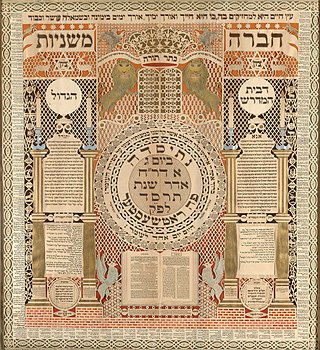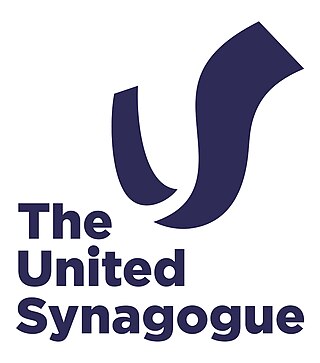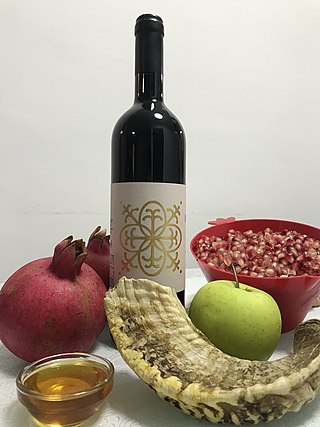
Passover, also called Pesach, is a major Jewish holiday, one of the three pilgrimage festivals, that celebrates the Biblical story of the Israelites' escape from slavery in Egypt. The Passover ritual is thought by modern scholars to have its origins in an apotropaic rite, unrelated to the Exodus, to ensure the protection of a family home.
Shemini Atzeret is a Jewish holiday. It is celebrated on the 22nd day of the Hebrew month of Tishrei in the Land of Israel, and on the 22nd and 23rd outside the Land, usually coinciding with late September or early October. It directly follows the Jewish festival of Sukkot which is celebrated for seven days, and thus Shemini Atzeret is literally the eighth day. It is a separate—yet connected—holy day devoted to the spiritual aspects of the festival of Sukkot. Part of its duality as a holy day is that it is simultaneously considered to be both connected to Sukkot and also a separate festival in its own right.

Messianic Judaism is a modernist and syncretic movement of Protestant Christianity that incorporates some elements of Judaism and other Jewish traditions into the Christian movement of evangelicalism.
Aleinu or Aleinu leshabei'ach, meaning "it is upon us" or "it is our obligation or duty" to "praise God," is a Jewish prayer found in the siddur, the classical Jewish prayerbook. It is recited in most communities at the end of each of the three daily Jewish services and in the middle of the Rosh Hashanah mussaf. It is also recited in many communities following Kiddush levana and after a circumcision is performed. It is second only to the Kaddish as the most frequently recited prayer in current synagogue liturgy.

Chabad, also known as Lubavitch, Habad and Chabad-Lubavitch, is an Orthodox Jewish Hasidic dynasty. Chabad is one of the world's best-known Hasidic movements. It is one of the largest Hasidic groups as well as one of the largest Jewish religious organizations in the world. Unlike most Haredi groups, which are self-segregating, Chabad mainly operates in the wider world and it caters to secularized Jews.

Shavuot, or Shvues in some Ashkenazi usage, commonly known in English as the Feast of Weeks, is one of the biblically-ordained Three Pilgrimage Festivals. It occurs on the sixth day of the Hebrew month of Sivan; in the 21st century, it may fall between May 15 and June 14 on the Gregorian calendar.

Counting of the Omer is a ritual in Judaism. It consists of a verbal counting of each of the 49 days between the holidays of Passover and Shavuot. The period of 49 days is known as the "omer period" or simply as "the omer" or "sefirah".

Hoshana Rabbah is the seventh day of the Jewish holiday of Sukkot, the 21st day of the month of Tishrei. This day is marked by a special synagogue service, the Hoshana Rabbah, in which seven circuits are made by the worshippers with their lulav and etrog, while the congregation recites Hoshanot. It is customary for the scrolls of the Torah to be removed from the ark during this procession. In a few communities a shofar is sounded after each circuit.

The United Synagogue (US) is a union of British Orthodox Jewish synagogues, representing the central Orthodox movement in Judaism. With 62 congregations, comprising 40,000 members, it is the largest synagogue body in Europe. The spiritual leader of the union is the Chief Rabbi of the United Hebrew Congregations of the Commonwealth – a title that bears some formal recognition by the Crown, even though his rabbinical authority is recognised by only slightly more than half of British Jews.

The Rosh Hashana kibbutz is a large prayer assemblage of Breslover Hasidim held on the Jewish New Year. It specifically refers to the pilgrimage of tens of thousands of Hasidim to the city of Uman, Ukraine, but also refers to sizable Rosh Hashana gatherings of Breslover Hasidim in other locales around the world. In recent years the pilgrimage to Uman has attracted Jewish seekers from all levels of religious observance and affiliation, including introducing Sephardic Jews to Hasidic spirituality. This has added to Breslov's position in the Baal teshuva movement of Jewish outreach.

Chabad.org is the flagship website of the Chabad-Lubavitch Hasidic movement. It was one of the first Jewish internet sites and the first and largest virtual congregation.
Abraham Hecht was a Chabad-affiliated American Orthodox rabbi, and president of the Rabbinical Alliance of America – Igud HaRabanim. Known as a "rabbi's rabbi" and a scholar of Torah, Hecht was regarded by some as one of America's most articulate Orthodox rabbinic leaders.
The history of the Jews in the United Arab Emirates describes the historical and modern presence of Jews over the millennia in the Middle East and the recorded meetings with Jewish communities in areas that are today in the geographic territories of the United Arab Emirates.
In 1986, the Israeli embassy in Kathmandu organized a Passover celebration as a service to the 7,000 Israelis who visit Nepal annually. The celebration was taken over in 1999 by the Chabad (/ħabad/) movement, a Hassidic Jewish movement that specializes in outreach to nonobservant Jews. Prior to 1986, there was no organized practice of Judaism in Nepal, and there is no native Jewish community.

Rosh HaShanah is the Jewish New Year. The biblical name for this holiday is Yom Teruah. It is the first of the Jewish High Holy Days, as specified by Leviticus 23:23–25, that occur in the late summer/early autumn of the Northern Hemisphere. Rosh Hashanah begins a ten-day period of penitence culminating in Yom Kippur, as well as beginning the cycle of autumnal religious festivals running through Sukkot and ending in Shemini Atzeret in Israel and in Simchat Torah everywhere else.
The history of the Jews in Vancouver in British Columbia, Canada has been noted since the mid-19th century.
Martyrdom in Judaism is one of the main examples of Jews doing a kiddush Hashem, a Hebrew term which means "sanctification of [the] name". An example of this is public self-sacrifice in accordance with Jewish practice and identity, with the possibility of being killed for no other reason than being Jewish. There are specific conditions in Jewish law that deal with the details of self-sacrifice, be it willing or unwilling.
Steven Blane is an American rabbi, cantor and recording singer-songwriter.

The Jewish community of Houston, Texas has grown and thrived since the 1800s. As of 2008 Jews lived in many Houston neighborhoods and Meyerland is the center of the Jewish community in the area.
Black Jews in New York City comprise one of the largest communities of Black Jews in the United States. Black Jews have lived in New York City since colonial times, with organized Black-Jewish and Black Hebrew Israelite communities emerging during the early 20th century. Black Jewish and Black Hebrew Israelite communities have historically been centered in Harlem, Brooklyn, The Bronx, and Queens. The Commandment Keepers movement originated in Harlem, while the Black Orthodox Jewish community is centered in Brooklyn. New York City is home to four historically Black synagogues with roots in the Black Hebrew Israelite community. A small Beta Israel (Ethiopian-Jewish) community also exists in New York City, many of whom emigrated from Israel. Black Hebrew Israelites are not considered Jewish by the New York Board of Rabbis, an organization representing mainstream Rabbinic Judaism. However, some Black Hebrew Israelite individuals in New York City are recognized as Jewish due to converting through the Orthodox, Conservative, or other Jewish movements.













